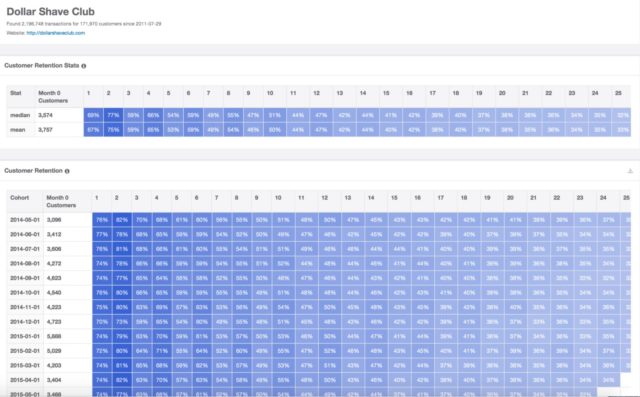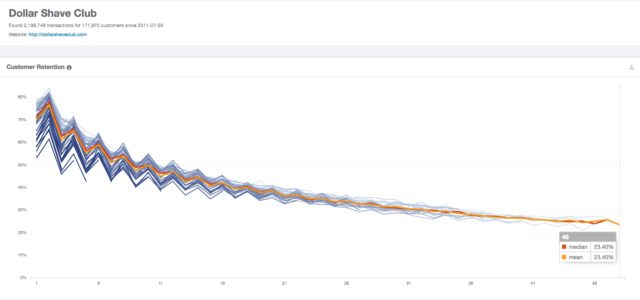By Nikhil Basu Trivedi, VC at Shasta Ventures. This article first appeared on Medium.
By now, you’ve probably heard of Dollar Shave Club.
From that video in 2012, to selling razors to millions of customers, to its acquisition by Unilever for $1B last year, founder/CEO Michael Dubin and the rest of the Dollar Shave Club team has executed incredibly well on many dimensions. They’ve made quality razors and blades much more affordable for consumers. They’ve built a brand that people love, that speaks authentically, and connects at an emotional level. The team has worked very hard to launch new products, improve margins, spend money effectively on advertising, and more. But there is one key element to the business that has made it so successful:
Subscription.
Dollar Shave Club built a direct-to-consumer subscription service for razors and other bathroom products. The company was projecting over $200M in revenue last year when it was acquired. And the retention in its subscriber base was the key reason for the company’s ability to make its unit economics work, and why it was such an attractive asset for an acquirer like Unilever.
What many people may have over-looked about the power of Dollar Shave Club is the power of subscription.
What many people may have over-looked about the power of Dollar Shave Club is the power of subscription.
Take a look at the customer retention cohort data below screen-shotted from Second Measure, a service that uses credit card transaction data to gain visibility on the performance of public and private companies. The percent figures correspond to the % of customers that transact in any given month (denoted by the number at the top of the tables). For instance, the top left % number, 69%, indicates that in the median monthly group of customers, 69% come back and transact in the first month after they initially made a purchase.
For instance, the top left % number, 69%, indicates that in the median monthly group of customers, 69% come back and transact in the first month after they initially made a purchase.

(For a better view, check the original post on Medium)
You’ll see at the top under “Customer Retention Stats” that for the median and mean monthly cohorts of customers, a significant percentage of customers (over 1/3) remain as subscribers even 24 months out.
Below this, you see that for Dollar Shave Club’s customers acquired in monthly cohorts in 2014–15, about 50% remain as subscribers in month 12.
An important aspect of the Dollar Shave Club subscription service is the “Not So Hairy” plan, where customers can skip a month of receiving blades. You’ll see that month 2 customer retention (73–82%) is higher than retention in month 1, meaning that more subscribers transact in their second month than in their first month, a manifestation of a significant portion of members skipping their first month delivery of blades and just receiving them in the second month.
Here’s a graph from Second Measure showing Dollar Shave Club’s customer retention by monthly cohort in a 4-year period (a way to visualize the above tabular cohort data):

(For a better view, check the original post on Medium)
Dollar Shave Club sees 23.40% of customers retained in month 48 — that’s almost 1/4 of its subscribers who are still subscribing to the service using the same credit card 4 years later! Note on the graph the upward bumps in retention every other month due to the “Not So Hairy” customers who subscribe to Dollar Shave Club bimonthly instead of every month.
Every great subscription business has a retention graph that asymptotes out significantly above zero, the higher the better of course. And the higher the retention, the higher the customer lifetime value, and the higher a business can justify spending to acquire a customer to grow revenue.
The company did not just get lucky.
The fact that Dollar Shave Club has high long-term retention of its subscription members is not down to luck.
People buy razors, need to change the blades frequently, and most people shave on a very regular basis… this is a product category that lends itself perfectly to subscription on a long-term basis.
The experience of buying razors in stores can be cumbersome — have you ever had to call a store representative to open up the razor cabinet? — and Dollar Shave Club made the online experience of subscribing to razors both simple and fun.
The company has also paid close attention to why subscribers churn, and has worked hard to address these issues and improve the likelihood that members will continue to subscribe.
Above all else, Dollar Shave Club has created an amazing consumer experience, and that has manifested itself in a subscription service that retains its users at high levels.
More to come on The Power of Subscription…
At Shasta Ventures, we were privileged to be investors in Dollar Shave Club’s first round of financing, led by our partner Sean Flynn. And we continue to be big believers in subscription businesses. Our partner Jason Pressman wrote a great piece in Forbes a few weeks ago about “The Not-So-New Promise Of The Subscription Economy”. We’ve invested early in companies like Zuora, a subscription management software platform that is used by leading subscription businesses and has its annual Subscribed conference next week. We’ve also invested in digital subscription services like Smule, Hinge, Zwift, and Canva, and in physical product subscription services in addition to DSC like The Farmer’s Dog, Perfect Coffee, and Imperfect Produce.
We’re also investors in Second Measure, and will be showcasing more of its data in future blog posts about subscription businesses. We’ll compare what retention looks like between different subscription services (ever wondered what Netflix’s retention looks like versus Spotify’s?). And we’ll look at businesses that are doing great, as well as ones that are not-so-hot or have failed.
Please follow Nikhil Basu Trivdei on Medium to get notified when the next post is published — you won’t want to miss it!